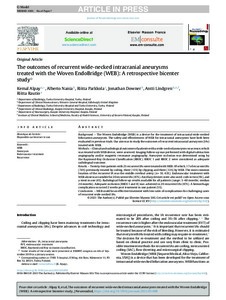The outcomes of recurrent wide-necked intracranial aneurysms treated with the Woven EndoBridge (WEB): A retrospective bicenter study
Alpay Kemal; Nania Alberto; Parkkola Riitta; Downer Jonathan; Lindgren Antti; Rautio Riitta
https://urn.fi/URN:NBN:fi-fe2021093048219
Tiivistelmä
Background: The Woven EndoBridge (WEB) is a device for the treatment of intracranial wide-necked bifurcation aneurysms. The safety and effectiveness of WEB for intracranial aneurysms have both been evaluated in previous trials. Our aim was to study the outcomes of recurrent intracranial aneurysms (IAs) treated with WEB.
Methods: Clinical and radiological outcomes of patients with a wide-necked aneurysm recurrence, which was treated with WEB device, were assessed. Imaging follow-up was performed with digital subtraction angiography and/or magnetic resonance angiography. Aneurysm occlusion was determined using by the Raymond-Roy Occlusion Classification (RROC). RROC 1 and RROC 2 were considered as adequate radiological outcome.
Results: Twenty-two patients with 23 recurrent IAs were treated with WEB. Of which, 17 of recurrent IAs (74%) previously treated by coiling, three (13%) by clipping and three (13%) by WEB. The most common location of the recurrent IA was the middle cerebral artery (n = 10, 43%). Endovascular treatment with WEB alone was suitable for 20 recurrent IAs (87%). Ancillary devices were also used: coils in two (9%), and a stent in one (4%). Radiological follow-up results available for all patients (range: 3-60 months; median 24 months). Adequate occlusion (RROC I and II) was achieved in 20 recurrent IAs (87%). A hemorrhagic complication occurred 2 weeks post treatment in one patient (5%).
Conclusions: WEB could be an effective treatment with low rates of complications for challenging cases of recurrent wide-necked IAs.
Kokoelmat
- Rinnakkaistallenteet [27094]
